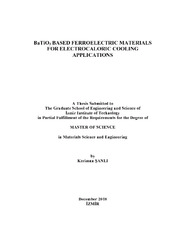Please use this identifier to cite or link to this item:
https://hdl.handle.net/11147/7187Full metadata record
| DC Field | Value | Language |
|---|---|---|
| dc.contributor.advisor | Adem, Umut | |
| dc.contributor.advisor | Akdoğan, Yaşar | |
| dc.contributor.author | Şanlı, Keriman | - |
| dc.date.accessioned | 2019-07-17T07:51:29Z | |
| dc.date.available | 2019-07-17T07:51:29Z | |
| dc.date.issued | 2018-12 | en_US |
| dc.identifier.citation | Şanlı, K. (2018). BaTiO3 based ferroelectric materials for electrocaloric cooling applications. Unpublished master's thesis, Izmir Institute of Technology, Izmir, Turkey. | en_US |
| dc.identifier.uri | https://hdl.handle.net/11147/7187 | |
| dc.description | Thesis (Master)--Izmir Institute of Technology, Materials Science and Engineering, Izmir, 2018 | en_US |
| dc.description | Includes bibliographical references (leaves: 48-51) | en_US |
| dc.description | Text in English; Abstract: Turkish and English | en_US |
| dc.description.abstract | The aim of this project was to produce electrocaloric materials and to determine the potential of these materials for electrocaloric cooling applications. The electrocaloric effect (ECE) of lead-free Ba0.8Sr0.2Ti1-xZrxO3 (0 ≤ x ≤ 0.10) ferroelectric ceramics was studied. The phase analysis of each ceramic composition that was synthesized by conventional solid-state reaction technique was performed by X-ray Diffraction. Dielectric measurements were done to determine the phase transition temperatures (Curie temperature, Tc) of all compositions and also construct a phase diagram. ΔT values were calculated indirectly using electrical polarization curves measured at different temperatures and Maxwell's equations. ΔT values that were obtained from different regions of the phase diagram are compared. The most suitable composition for applications was chosen considering the ΔT value, temperature range where relatively large ΔT is preserved and the Curie temperature of all ceramics. Ba0.8Sr0.2Ti0.93Zr0.07O3 ceramic located near the critical point shows the best performance with ΔT value of 0.40 K under 20 kV/cm. In comparison with the lead-free ceramics studied in the literature, Ba0.8Sr0.2Ti1-xZrxO3 system can be considered as one of the best candidates for future electrocaloric cooling technologies. | en_US |
| dc.description.sponsorship | Turkish Scientific and Technological Research Council (315M241) and IZTECH | en_US |
| dc.format.extent | x, 51 leaves | en_US |
| dc.language.iso | en | en_US |
| dc.publisher | Izmir Institute of Technology | en_US |
| dc.rights | info:eu-repo/semantics/openAccess | en_US |
| dc.subject | Electrocaloric materials | en_US |
| dc.subject | Ferroelectric ceramics | en_US |
| dc.subject | Electrocaloric effect | en_US |
| dc.title | BaTiO3 based ferroelectric materials for electrocaloric cooling applications | en_US |
| dc.title.alternative | Elektrokalorik soğutma uygulamaları için BaTiO3 temelli ferroelektrik malzemeler | en_US |
| dc.type | Master Thesis | en_US |
| dc.institutionauthor | Şanlı, Keriman | - |
| dc.department | Thesis (Master)--İzmir Institute of Technology, Materials Science and Engineering | en_US |
| dc.relation.tubitak | info:eu-repo/grantAgreement/TUBITAK/MAG/315M241 | |
| dc.relation.publicationcategory | Tez | en_US |
| item.languageiso639-1 | en | - |
| item.fulltext | With Fulltext | - |
| item.openairecristype | http://purl.org/coar/resource_type/c_18cf | - |
| item.openairetype | Master Thesis | - |
| item.grantfulltext | open | - |
| item.cerifentitytype | Publications | - |
| Appears in Collections: | Master Degree / Yüksek Lisans Tezleri | |
Files in This Item:
| File | Description | Size | Format | |
|---|---|---|---|---|
| T001867.pdf | MasterThesis | 4.39 MB | Adobe PDF |  View/Open |
CORE Recommender
Page view(s)
256
checked on Jul 22, 2024
Download(s)
174
checked on Jul 22, 2024
Google ScholarTM
Check
Items in GCRIS Repository are protected by copyright, with all rights reserved, unless otherwise indicated.